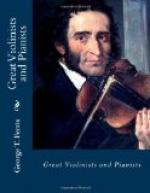IV.
In 1836 and 1837 Ole Bull gave one hundred and eighty concerts in England during the space of sixteen months. By this time he had become famous, and a mere announcement sufficed to attract large audiences. Subsequently he visited successively every town of importance in Europe, earning large amounts of money and golden opinions everywhere. For a long time our artist used a fine Guarnerius violin and afterward a Nicholas Amati, which was said to be the finest instrument of this make in the world. But the violin which Ole Bull prized in latter years above all others was the famous Gaspar di Salo with the scroll carved by Benvenuto Cellini. Mr. Barnett Phillips, an American litterateur, tells the story of this noble old instrument, as related in Ole Bull’s words:
“Well, in 1839 I gave sixteen concerts at Vienna, and then Rhehazek was the great violin collector. I saw at his house this violin for the first time. I just went wild over it. ‘Will you sell it?’ I asked. ‘Yes,’ was the reply—’for one quarter of all Vienna.’ Now Ehehazek was really as poor as a church mouse. Though he had no end of money put out in the most valuable instruments, he never sold any of them unless when forced by hunger. I invited Rhehazek to my concerts. I wanted to buy the violin so much that I made him some tempting offers. One day he said to me, ’See here, Ole Bull, if I do sell the violin, you shall have the preference at four thousand ducats.’ ‘Agreed,’ I cried, though I knew it was a big sum.
“That violin came strolling, or playing rather, through my brain for some years. It was in 1841. I was in Leipsic giving concerts. Liszt was there, and so also was Mendelssohn. One day we were all dining together. We were having a splendid time. During the dinner came an immense letter with a seal—an official document. Said Mendelssohn, ’Use no ceremony; open your letter.’ ‘What an awful seal!’ cried Liszt. ’With your permission,’ said I, and I opened the letter. It was from Bhehazek’s son, for the collector was dead. His father had said that the violin should be offered to me at the price he had mentioned. I told Liszt and Mendelssohn about the price. ‘You man from Norway, you are crazy,’ said Liszt. ‘Unheard of extravagance, which only a fiddler is capable of,’ exclaimed Mendelssohn. ’Have you ever played on it? Have you ever tried it?’ they both inquired. ‘Never,’ I answered, ’for it can not be played on at all just now.’
“I never was happier than when I felt sure that the prize was mine. Originally the bridge was of boxwood, with two fishes carved on it—that was the zodiacal sign of my birthday, February—which was a good sign. Oh, the good times that violin and I have had! As to its history, Ehehazek told me that in 1809, when Innspruck was taken by the French, the soldiers sacked the town. This violin had been placed in the Innspruck Museum by Cardinal Aldobrandi




